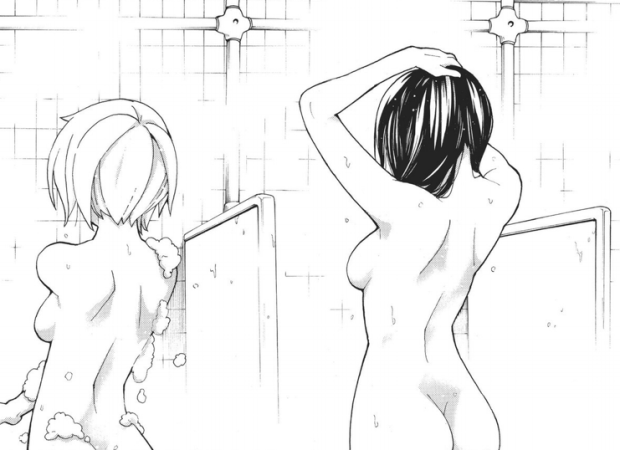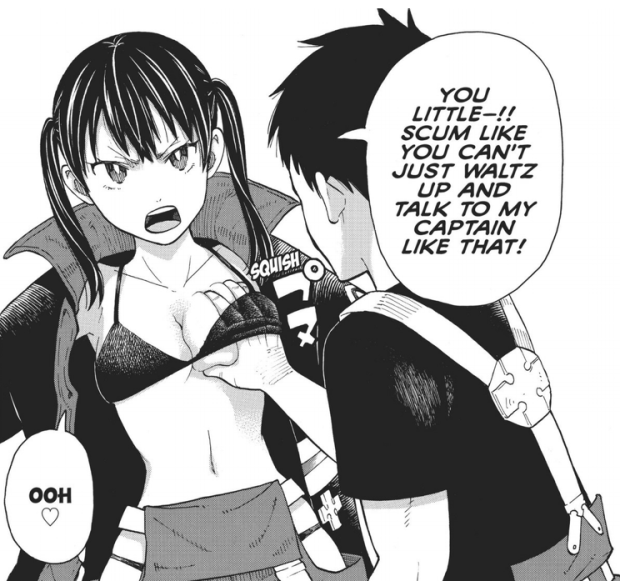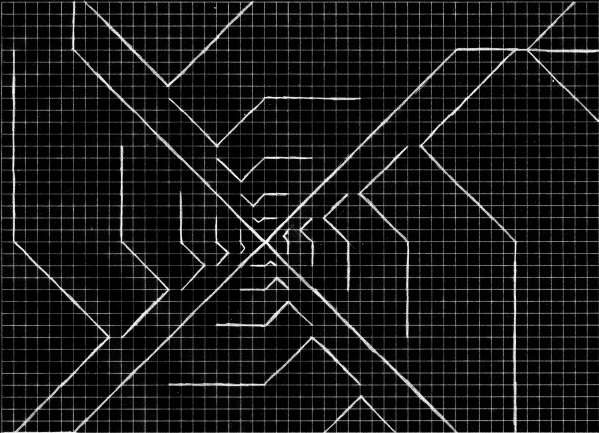Fire Force. Written and illustrated by Atsushi Ohkubo. Translated into English by Alethea Nibley and Athena Nibley. Kodansha, 2016.
Shinra Kusakabe wants to be a hero. Having lost his mother and infant brother in a fire, he has joined a fire department to save others from similar fates.
But this fire department doesn’t just put out fires. They also fight fire monsters that plague Tokyo.
And Shinra himself has fire abilities similar to these demons.

Oh, and everything’s on fire.
En En Shoutabai, localized for United States English readers as Fire Force, is a manga series that began in 2015 and is written and illustrated by Atsushi Ohkubo, the creator of the series Soul Eater. Distributed in Japan and the United States by Kodansha, Fire Force has much in common with Ohkubo’s previous manga. This includes the good–an involved storyline, conspiracies, characters with clear and broad personalities, shifts in alliances, quirky humor, detailed illustrations–and the bad–a long time setting up the plot, characters, and setting, repetitive humor, adding more characters than its prepared to handle, and needless, redundant, superfluous, female-objectifying fanservice.
This review focuses on Volume 1, Chapters 0 to 5, released by Kodansha and translated by Alethea Nibley and Athena Nibley, although there will be spoilers up to the most recent chapter released in Japan, Chapter 70.
In Chapter 0, “Shinra Kusakabe Joins the Force,” we start with a prologue not unlike the opening to Soul Eater, complete with Ohkubo’s unique skull design that has been present since his first published manga, B. Ichi. This exposition gives way to seeing it actually take place: this is a world where the average human can spontaneously combust.
Our hero, Shinra, is waiting for his train when he sees the now transformed flame monster exit and–

HELLO, NIGHTMARE FUEL! That’s going to be in my dreams for a while.
Before Shinra can intervene, he is interrupted by the arrival of the Special Fire Force Division Eight (one of many references to Ohkubo’s prior series Soul Eater), who first put out the fire on the monster flames before allowing their squad leader, the muscular and tall Akitaru Obi, to deliver the final blow. As Obi lands the hit, the squad’s resident nun, Iris, prays for the purification of the monster’s soul. Watching the battle from the sidelines, Shinra notices debris about to fall onto Iris, swooping in to rescue her and revealing he too has flame abilities. He introduces himself to the Eighth, who have been expecting him: he was taking the train because he’s their newest recruit. My, how convenient.
The eighth takes Shinra to their headquarters, a cathedral converted into a fire station. (So, is that better or worse than moving the Ghostbusters to the Chinese restaurant in the 2016 reboot?)
Shinra gets the introductions: quad leader Obi is a fitness fanatic because he has no superpowers, so he makes up for it with raw strength; his second-in-command Takehisa Hinawari is a military man who is overly serious (and tragically born without eyelids), and the remaining members, Iris and Maki, are–
 –…fanservice bait.
–…fanservice bait.
Okay, that’s not entirely fair, as the fanservice does subside in _most_ later issues…while still creepily targeting the female characters, as is typical with Ohkubo.
Anyway…Iris is a sister who left her church following a fire that killed almost all of her fellow nuns, and Maki was with Takehisa in the military–and while a powerful brawler with the ability to control flames, she is a bit distracted by cute things and romantic notions.
This chapter and the next one also fill in backstory for Shinra. When his mother and brother died in the house fire, he was blamed for it, as it was that same event where he discovered his ability to light his legs on fire. Unable to respond to the overwhelming despair he feels, the young child breaks out into a nervous grin, mistaken as as if he is ecstatic that his mother and brother are dead. The grin and his fire abilities earn him the derisive name of “demon,” and that name-calling and that formative event are what inspired Shinra to join the Fire Force, to learn how to control his flames, and to be a hero.
Wait. A guy who can flame on, is called a demon, has a toothy grin, and whose name contains the letters “R-I-N”–Oh, come on!
Moving onto Chapter 1, “First Run,” the Eighth is called out in the middle of the night to contain a fire monster that is burning down a factory. The monster is the factory foreman’s wife, who begs the squad to put his wife to rest. As Shinra copes with the trauma of his past, he finally works up the courage to put down the flame monster and let her soul be at rest. Upon being thanked by the foreman, gone is the demon’s smile, replaced with that of a hero.
Chapter 2, “The Devil, the Knight, and the Witch,” explains Shinra and Maki’s divergent fire abilities: Maki, the witch in this title, can only control fire that she starts by conventional means, while Shinra, the devil, can summon flames independently along his legs. That just leaves the knight, Arthur Boyle, Shinra’s former classmate and newly assigned member of the Eighth. Arthur has a knight complex, imagining himself, whether out of intention or delusion, of being from the medieval era. When he looks at his surrounds, he either mistakes them for objects, persons, and creatures in Arthurian legend, or is purposefully calling them as such to stick this motif of being the knight in shining armor. Like Shinra, he can summon flames, which he channels around his sword, Excalibur (another Soul Eater reference).
As their superior officer, Maki trains Shinra and Arthur, showing them that, despite being unable to generate flames, her military training and ability to control fire allows her to manipulate the boys’ own flames, turning off Shinra’s fiery legs so he can’t fly, and disabling Arthur’s Excalibur. Realizing he is poorly trained to battle Maki, Shinra vows to get stronger.
Chapter 3, “The Heart of a Fire Soldier,” and Chapter 4, “The Sinister Blasphemer,” has the team respond to another flame monster, in this case the father of a young woman. Unlike previous flame monsters, this widower is forcing himself to remain in control until the fire squad can arrive and put him down. The transformation hints at something more complex than a simple spontaneous combustion, and it disassociates the ability of becoming a monster from simply becoming mindless.
And here I get into spoilers for future chapters…
As later chapters will show, flame monsters are not simply one type of rampaging force of nature but a variety of mental and emotional states. My friend, Ivan Navi, spent a bit of time looking at these chapters for how they reveal Obi’s compassion: even as he is the one to knock out flame monsters, he recognizes they are literally killing people and discourages Shinra and Arthur from displaying their weapons in public, lest they traumatize the monster’s loved ones who are already suffering, especially as becoming a flame monster is usually hereditary. These two chapters also introduce two morally gray characters, the team of the cigarette-smoking pyrokinetic Joker and his fluffy-hair partner Victor Licht, who have concocted some way to augment flames with gunpowder, who terrorize civilians and flame humans alike, and who know that Shinra’s brother, Sho, actually survived the fire–and entice Shinra with knowledge where to find him.
Chapter 5, “The Rookie Fire Soldier Games,” is by far the weakest chapter in Volume 1, and a blotch on the series overall. Back in Chapter 2, Obi said he was sending Shinra and Arthur to participate in a mock tournament between the new recruits of the eight squads. At this point, the chapters are not as well connected as they will in later arcs. Volume 1 is primarily world-building with a bit of exposition about characters’ motivations in order to present their personalities. The games, thrown in to Chapter 5, feel like a half-baked story arc that wants to be analogous to the Chuunin Exams from Naruto, only this one in Fire Force is an exhibition on proper search and rescue techniques in fire departments.
 And speaking of exhibition, we’re introduced to another main character, Tamaki Kotatsu, who like her black-cat appearance, has a run of bad luck that makes her susceptible to poorly written fanservice gags. Thanks, Ohkubo!
And speaking of exhibition, we’re introduced to another main character, Tamaki Kotatsu, who like her black-cat appearance, has a run of bad luck that makes her susceptible to poorly written fanservice gags. Thanks, Ohkubo!
Honestly, Tamaki is a fine character, but she is poorly handled and reduced to a one-note joke so that Ohkubo can include cheesecake shots and opportunities for boys to grope girls in some sad attempt at what the creator imagines to be what young male readers want in their manga. The fanservice gags are so bad that Hiro Mashima, the creator of Fairy Tail, said in an interview that he was impressed how unique Ohkubo’s fanservice gags were in Fire Force and how it was unlike anything he has seen in manga. Look, when Mashima, the guy who has given us this, this, and this, is praising your fanservice, _that is not a compliment_.
Okay, enough soapboxing: back to the plot.
The tournament introduces the other seven squads, as well as the different institutions who have collaborated to make the Fire Force squadrons: leaders of religious, business, and civic affairs in Tokyo, including the guy with the big hair, the previously introduced Victor Licht. Also at the tournament is Leo Burns, the leader of squad one and the firefighter who was at Shinra’s house when it burned down. When Shinra tries to ask Burns questions, he is rebuffed, hinting at the conspiracy that unravels in later chapters.
When the tournament begins, the new recruits run into the factory for mock search-and-rescue. Shinra, however, is confronted by Joker, who has information about the fire that destroyed Shinra’s house, and can provide Shinra with answers about what happened to his infant brother.
Volume 1 ends on that note, followed by a short gag featuring Ohkubo himself. The Japanese release of this volume included a bio for Shinra, which is included in Volume 2 in the United States release, and meta-commentary by Soul and Maka from Soul Eater, which unfortunately does not appear in the United States release.
With the plot out of the way, let’s look at larger details of the manga.
As Ivan Navi touched upon, this is a world where people have to be okay with putting down other people. It seems like Ohkubo takes ideas that were inherent to his earlier works and takes them to a logical conclusion. Whereas Soul Eater rarely reflected on the morality about Lord Death assigning children to assassinate his enemies, in Fire Force Obi leads his squad members to recognize they are intentionally killing people and have to show not only respect to these victims but also to the families who are going to mourn how their loved ones are put down. This detail becomes more relevant as it differentiates the Eighth Fire Force from the other seven, which hints at something corrupt within the other branches.
While this corruption serves as the plot to the overall series, Volume 1’s focus is on Shinra. The character is a typical shonen protagonist: he wants to avenge his mother’s death, reunite with his lost brother, and demonstrate that even the most socially awkward, creepy guy has what it takes to be a hero.
Unlike other shonen protagonists, Shinra starts off largely in control of his skills with fire, far more than other heroes who are introduced as still trying to figure out how to use their newly discovered powers. Although Shinra is going to learn greater command of his abilities, the story does not really focus on unique uses of his flame abilities. There will be characters who use flames to pull oxygen out of the air and more creative uses, so having Shinra’s abilities primarily for kicking and flight can be a bit dull. Ohkubo seems to draw upon breakdancing as analogous to Shinra’s style to fighting, so perhaps the limitations is inherent to the comic book form and would not be apparent when animated for a television series.
Shinra’s personality is realistic enough because his demeanor changes depending on with whom he speaks. He shows respect to his superiors, he is at a loss contending with Arthur’s fantasies of being a knight, and he recognizes how eccentric are the members of the Eighth. I don’t know how realistic are Shinra’s initial interactions with Maki and Iris, as the convention of the adolescent boy being awkward around girls and being mistaken for–or properly identified as–pervy seems less about showing the struggle for many young people and more just fodder for fanservice. As Shinra is 19, having him still look and act like a 14-year-old seems off–and unfortunately, because Shinra frequently falls into awkward situations with women, I’m still disconcerted.
Recommendation: Check it out at the library
Volumes of Fire Force are available in English in the United States at most bookstores and online vendors as both physical books and eBooks. Amazon recently had Volume 1 on sale for 99 cents, so be on the lookout for bargain shopping. I would recommend jumping into the series at Chapter 9 in Volume 2, which is out already in the United States, and if you like what you see and enjoyed Soul Eater, buy more of the series. Otherwise, this book is something to skim at the library or to buy on sale.
Advertisements Share this:




